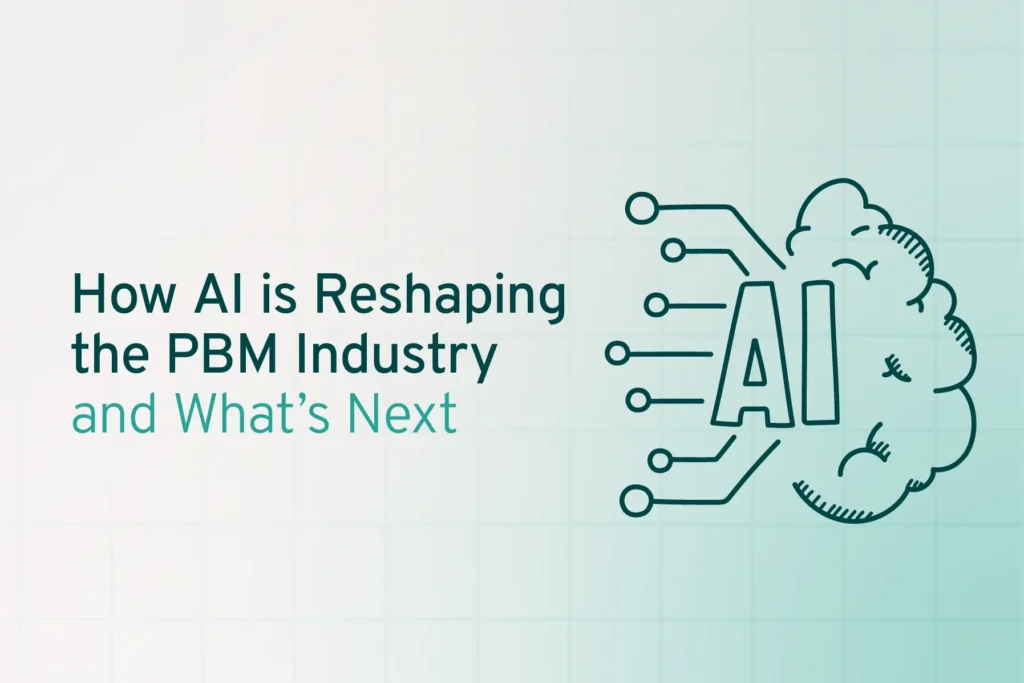
How AI is Reshaping the PBM Industry—And What’s Next
How AI is Reshaping the PBM Industry—And What’s Next
The pharmacy benefit management (PBM) industry isn’t exactly known for speed and efficiency, but artificial intelligence (AI) is changing that. We’re seeing a seismic shift in how PBMs operate, with AI streamlining processes and driving innovation in ways we never thought possible. And while the promise of AI is exciting, there are challenges to navigate along the way.
How AI is Transforming The PBM Industry
AI is making its mark across the PBM industry, particularly in the automation of pharmacy-related tasks that once took hours or even days. Processing prior authorizations, for example, is a historically cumbersome process that can delay patient access to medications. With AI, approvals can be expedited by analyzing medical histories and identifying patterns that support faster, more accurate decision-making.
But it’s not just about speed. AI is also improving medication adherence and patient engagement. Predictive analytics can assess patient behavior and flag those at risk of missing doses, prompting proactive outreach. Automated systems can handle prescription inquiries, provide real-time updates on drug availability, and even suggest alternative medications based on cost and coverage—ensuring patients receive the best possible treatment without unnecessary delays.
While I don’t think AI is a replacement for human interaction, one thing that I’ve found particularly interesting is AI’s ability to mimic human empathy. A study published in JAMA Internal Medicine found that AI-generated responses to patient questions were rated higher in both quality and empathy compared to responses from physicians. This suggests that AI has the potential to enhance communication and improve patient satisfaction, reinforcing the idea that AI isn’t just about efficiency—it can also support a more human-centered approach to care.1
Challenges in the AI Revolution
Of course, with innovation comes hesitation. One of the biggest concerns surrounding AI in PBM—and healthcare in general—is data privacy. We’re dealing with sensitive patient information, and while AI can enhance security measures, it also introduces new risks. Striking a balance between AI-powered efficiency and stringent data protection is something the industry is still figuring out. Some examples of this include:
1. Data Breaches and Cyberattacks: As with any healthcare-related organization, PBMs are prime targets for cyberattacks. If hackers infiltrate the PBM’s systems, they could access vast amounts of personal and medical data. AI-driven cyberattacks, such as automated scanning for vulnerabilities in PBM systems, can be used to exploit weaknesses and gain unauthorized access to sensitive data.
2. Sensitive Health Data Exposure: PBMs handle sensitive patient data, including prescription histories, medication adherence information, and health conditions. If AI systems are used improperly or are compromised, there’s a risk that this data could be exposed or accessed by unauthorized individuals. This could lead to violations of HIPAA and other privacy regulations, resulting in hefty fines and reputational damage. However, there are best practices for securing PHI when using Large Language Models (LLMs), such as:
– Anonymization — Removing personally identifiable information (PII) before data is sent to AI systems ensures that PHI remains protected while still allowing AI to analyze patterns and generate insights.
– Tokenization — Instead of transmitting raw PHI, organizations can replace sensitive data with unique tokens. These tokens can be mapped back to the original data within a secure environment, preventing unauthorized access while still enabling AI functionality.
– On-Premises or Private Cloud AI Solutions — Instead of sending PHI to external AI models, organizations can implement AI solutions within their secure cloud infrastructure. This minimizes the risk of exposing sensitive data to third-party AI providers.
– Strict Access Controls and Logging — Ensuring that only authorized personnel and AI applications have access to PHI is critical. Additionally, detailed logging and monitoring should be in place to track when and how PHI is accessed by AI systems.
3. AI-Driven Predictive Analytics: Many PBMs use AI-driven predictive analytics to forecast drug utilization trends and manage formularies. However, inaccuracies in the predictive models, often due to biased data, can lead to incorrect decisions about medication coverage or pricing. This could impact patient access to medications or lead to cost overruns for employers and health plans.
Then there’s the trust factor. Patients and healthcare providers alike may be wary of relying too much on AI-driven systems. People want to know that the “human” side of care isn’t disappearing, even as machines become more sophisticated.
The Future: AI and Drug Development
Beyond PBM operations, AI is also shaking up the pharmaceutical world, particularly in the creation of new drugs. AI-driven models are helping researchers predict how compounds will interact, accelerating the drug discovery process. This could mean faster development of life-saving medications and more personalized treatment options.
One notable example is how artificial intelligence has dramatically advanced the field of protein structure prediction. In the CASP (Critical Assessment of Structure Prediction) competition, which once saw only occasional accurate models of protein tertiary structures, AI systems like DeepMind’s AlphaFold have achieved unprecedented accuracy across nearly all targets. What once took researchers months or even years per protein can now be done in minutes, with AlphaFold predicting the structures of over 200 million proteins—essentially the entire known protein universe—in under two years. Revelation of the 3D shapes of target proteins is critical to the development of drugs designed to bind to them.23
The intersection of AI and PBM isn’t just about operational improvements, it’s about redefining healthcare and how different sectors work together. The challenge is ensuring we use AI responsibly, balancing efficiency with empathy, and keeping a tight rein on security measures. The future isn’t just AI-driven; it’s AI-enhanced, and that’s an exciting prospect.
Want to see how ChoiceScripts is leveraging AI to improve pharmacy benefits?
Let’s talk.
1JAMA Internal Medicine
2DeepMind Blog: AlphaFold Reveals the Structure of the Protein Universe
3Nature: Highly accurate protein structure prediction with AlphaFold
